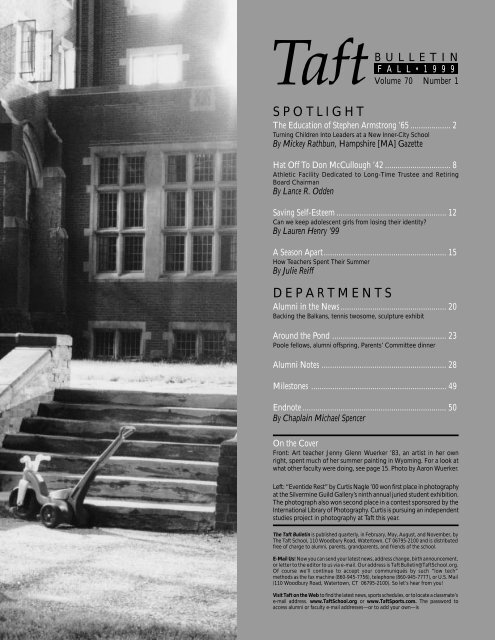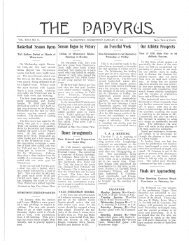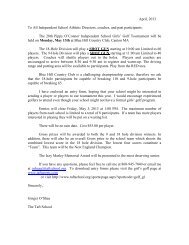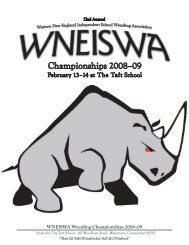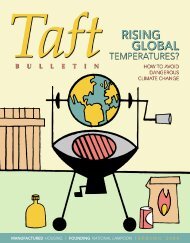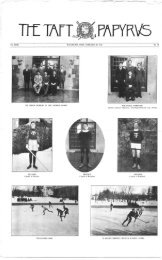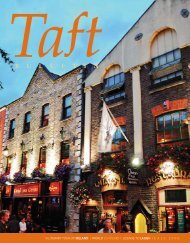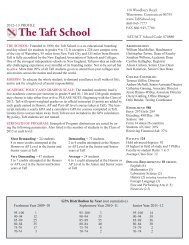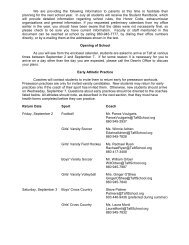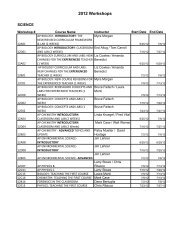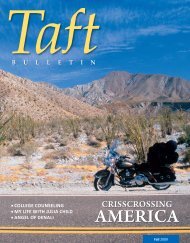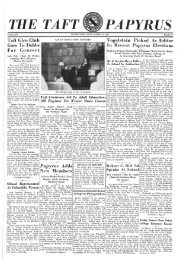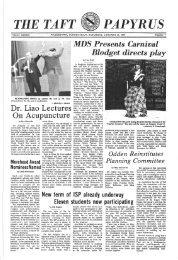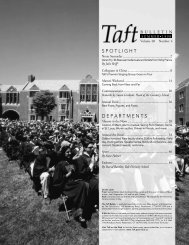By Lauren Henry '99 - The Taft School
By Lauren Henry '99 - The Taft School
By Lauren Henry '99 - The Taft School
- No tags were found...
You also want an ePaper? Increase the reach of your titles
YUMPU automatically turns print PDFs into web optimized ePapers that Google loves.
S P O T L I G H T<strong>The</strong> Education ofSTEPHENARMSTRONGHow One Psychologist Is Trying To Turn Children IntoLeaders at a New Inner-City <strong>School</strong><strong>By</strong> Mickey Rathbun, Hampshire GazettePhotography by Jerrey RobertsAt 7:30 on a cold, rainy March morning, Dr. Stephen Armstrong ’65 iswaiting in a barren courtyard behind the Van Sickle Junior High <strong>School</strong>building in Springfield, MA, for the school bus to discharge its passengers.In his fire-engine red rain jacket and matching rain pants, he looks like a beacon.“Good morning, Mr. Clark. Good morning, Mr. Rios, how’re you doing?”Armstrong welcomes each child with a personal greeting and a heartyhandshake. One boy says, “Morning, Doc!” and gives Armstrong a hug. A girlsees his rain gear and exclaims, “You look so funny!” Stephen Armstrong, educational director and teacher at the New Leadership Charter <strong>School</strong> in Springfield, MA, begins his day bygreeting children as they arrive at school.<strong>Taft</strong> Bulletin 3
S P O T L I G H TArmstrong, a psychologist specializingin children and adolescents, is afounder and educational director of therecently opened New Leadership Charter<strong>School</strong>. <strong>The</strong> school occupies thesecond floor of Van Sickle, a decrepit,Depression-era, Neo-Classical heap of abuilding. In the parking area whereArmstrong meets the students, three pairsof rusted, bent basketball hoops face offacross a span of broken asphalt.Starting with only seventh graderslast year, the school will add a grade everyyear until the first class graduatesfrom high school in 2004. Unlike somecharter schools, this one is not an alternativeschool or a special educationschool, although approximately onethirdof its students have special needs.It’s a college preparatory school for inner-citychildren who are willing tocommit themselves to a rigorous educationalprogram that includes a dresscode, Saturday classes and leadershiptraining with the National Guard.Armstrong makes a point with student Marcus Parks in one of the two reading classeshe teaches.STEPHENARMSTRONG grew upas the son of a prominent investmentbanker who was head of the Securitiesand Exchange Commission and secretaryof the Navy in the Eisenhower administration.Armstrong went to SidwellFriends and <strong>Taft</strong> before going to Harvard,where he majored in social relations, acombination of psychology, sociologyand anthropology. While at Harvard,Armstrong met his wife, Jeanne, then aRadcliffe student, and they eloped duringtheir senior year.Armstrong pursued his interest inpsychology, earning a Ph.D. in HumanDevelopment at the Institute for ChildStudy at the University of Maryland.He did postgraduate work in psychotherapyat Case Western Reserve andVanderbilt universities.<strong>The</strong> Armstrongs settled in Hadleyin 1977, when Jeanne enrolled in the4 Fall 1999
S P O T L I G H Tkids have. Most kids put their brains inthe deep freeze for three months, and ittakes another three months to thaw themout. I also wanted to give disenfranchisedkids opportunities they didn’t have,” saysArmstrong. “And I wanted to be witnessto what happens in the inner city. Veryfew white people are involved with inner-citykids.”Armstrong developed the YLC overthe next several years, gaining the admirationof many members of theSpringfield community, black and white.<strong>By</strong> 1996, he felt it was time to branchout. “I was pleased with what the kidswere getting out of the Youth LeadershipCircle, but it was clear to me that weneeded more than the summer thing, andI knew I couldn’t do it alone.”Armstrong began to explore thepossibility of starting a charter school.Charter schools, allowed under Massachusetts’Education Reform Act of1993, are publicly funded schoolsformed by parents, activists, and privateorganizations. <strong>The</strong>y are intended toemploy innovative curriculums or teachingapproaches. <strong>The</strong>re are 37 of theseoperating in the state and six more havebeen approved.“I wanted to rewrite the script for citykids,” he says. Based on statistics gatheredby the Massachusetts Departmentof Education, Amstrong concluded,“An average city kid is two years behindsuburban kids in math and reading.“We want to counteract the basicassumption that these inner-city kidswon’t grow to be leaders,” explainsArmstrong. “We assume that they areleaders. We affirm their leadership everyday. Our notion was to start with apositive expectation for every child, andto understand we’d go through troubleswith each child. Most public schools areafraid of troubles; teachers have low expectationsand don’t demand muchfrom the students. Here we get to knowthe students very well, and we won’tcompromise our expectations. We takethe trouble.”ARMSTRONGQUICKLY discovered thatstarting a school, no matter how lofty thegoals, is no easy task. <strong>The</strong> beginning ofthe school year was “unbelievably stressful,”recalls Armstrong. “We were makingit up as we went along.”He recruited students by word ofmouth and by sending announcementsto parents. For the first two months, theschool had no telephones. And althoughthe school has a makeshift computer lab,it does not yet have Internet access.“We’re operating in a crazy environment,”says Armstrong. “And we’re tryingto make it rational.” Periodically a loudbeeping sound reverberates throughoutthe building. “I don’t know what that is,”he says, with a touch of annoyance.“I wanted to rewrite the script for city kids.”landscape architecture department at theUniversity of Massachusetts. Armstrongspent eight years as a psychologist atBaystate Medical Center in Springfieldbefore starting his own practice in 1984,working mostly with white, middle-classchildren and their families.<strong>The</strong> Armstrongs’ lives took a neartragicturn in 1988 when their14-year-old son, Ian [’92], was seriouslyinjured by a truck in a hit-and-run accident.He eventually recovered. ButArmstrong, like many people who suffera personal crisis, sought solace in religion,and he began attending Grace EpiscopalChurch in Amherst. “It was sort of a conversionthing for me.”A significant aspect of Armstrong’srekindled spirituality was his desire tomake the world a better place. While prayingone day, he began thinking about whatskills he might use toward this end. Hedecided his passion for tennis and readingcould be paired in a way that couldbenefit children. In 1991, he launched theYouth Leadership Circle (YLC), a summerprogram for Springfield inner-citychildren who learned to play tennis andspent time reading with an emphasis onBible verses and Shakespeare. “It soundsso corny,” he says. “Nobody believes thatthese little epiphanies can really happen.”<strong>The</strong> YLC brought together theseseemingly disparate activities, helpingchildren develop physical and mentalskills and at the same time building selfconfidenceand self-esteem. <strong>The</strong> summerprogram culminated every year with atrip to Lenox to watch a Shakespeare andCo. production. <strong>The</strong> students preparedfor the event by reading the play andmemorizing speeches from it.“I wanted to provide an antidote tothe usual unstructured summer most city<strong>By</strong> seventh grade, formal ideas aboutidentity are beginning to form. City kidsare incorporating the notion that they’redefective, that they’re not capable, orintelligent, or adept. And from seventhgrade on, the gap accelerates. <strong>By</strong> the timea kid is in ninth grade, he knows he’s ina game he can’t win.”Armstrong admits there have beenmoments when he wonders whether hehas the strength to continue. At thosetimes, he reminds himself of the pridehe felt listening to the drill cadence thatthe students composed at NationalGuard camp: “Dr. Armstrong can’t yousee, What a leader you made of me!”<strong>Taft</strong> Bulletin 5
S P O T L I G H TBradley Brown takes a moment to think while finishing a spelling test in English class.EIGHTY-NINE students, whose achievementranged from third to 12th-grade level,were originally enrolled in the NewLeadership Charter <strong>School</strong> when itssummer semester began in 1998. <strong>The</strong>students were required to read fourbooks, which was a substantial challengefor most of them. Armstrong wanted toassess the group’s reading level and togive them a sense of what the schoolwould require of them. Twenty-fivedropped out before the fall.With classes held 220 days a year,including Saturday mornings, morethan any other school in the state, theNew Leadership Charter <strong>School</strong> demandsa lot from students and theirparents. While some students regularlyskip Saturdays, those who come say theydon’t mind it. “It gives us something todo,” says honor-roll student Daniel Rios.“It really helps us. Three extra hours aweek move us towards succeeding.”Order and discipline are major aspectsof the school’s program, andArmstrong is always vigilant. As studentsgo between classes, he stands outside hisoffice chatting with them and spottingthose who are out of uniform, headinginto the wrong classroom, or otherwiseout of line.“That’s a chewing-gum smile,” hesays to a girl who passes by, reminding herthat gum chewing is not allowed. Anothergirl comes to tell him she is unpreparedfor a test because she went to church thenight before. “When did you learn aboutthe test?” he asks. Reluctantly she admitsshe’s known about it since the week beforeand he sends her off to take it.A teacher stops to consult withArmstrong about a chronically troublesomestudent who came to schoolwearing improper shoes and is spendingthe day in his stocking feet. Accordingto Armstrong, this boy has major familyproblems, and teachers in other schoolshave assumed that he is simply unteachablebecause of his unruliness. “He hatesit when we’re tough on him, but we needto be,” says Armstrong. “He’d disintegratein regular public school. He issearching for a structure he can be securein. He’ll strike out until he findssomething to attach to. With lots of kidslike this, it’s the police.”Armstrong points out that despitethe boy’s attitude problems, his test scoresshow he is the third-most-improved studentin the school. “A confrontation canbe loving,” explains Armstrong. “You sayto a kid, ‘You can do it,’ but you muststick with them. <strong>The</strong>se kids need rigorand tests, but that’s not all they need.<strong>The</strong>y need people who are trying to understandtheir emotional lives, peoplewho will meet them halfway.”6 Fall 1999
S P O T L I G H T<strong>The</strong> school’s academic programstresses diligent classroom participationand regular drills to prepare for citywidestandardized testing. <strong>The</strong> classesrange from eight in the weaker groupsto 17 in the most advanced.One of Armstrong’s basic strategiesis providing students with realistic goalsand criteria on which they are to begraded. “In some schools,” he explains,“teachers are notoriously unclear aboutwhat they expect.” He gives the studentsin his two reading classes written Objectivesand Assessments.Armstrong meets with each of hisstudents every week to review progressand to design a success plan for theweek. He acknowledges that some of hisstudents have challenged his demandingteaching style: “<strong>The</strong>y said, ‘What isit with this Harvard-educated whiteguy? We can’t keep up.’” He is workingto banish this attitude. “First,” he explains,“we talk about their fear. Next,we look at what they assumed they werebeing asked to do. <strong>The</strong>n, we unlearn thejunk about giving up when you’re behindand think you can’t do it. And thenwe do it, step by step.”He believes the process is working;test scores reflect that even the most resistantstudents are making substantialgains. Armstrong’s rigorous academicprogram isn’t entirely popular with thefaculty, either, because it requires a lotof paper grading and vigilance on theirfrustration with the union mentality ofsome teachers, who, for example, refuseto sit with the students at lunch becauseit’s not in their contract. “<strong>The</strong> union hasa contentious attitude at school, and itdoesn’t help the students, it only representstheir interests,” he says.BIBLEREADINGS have been animportant part of Armstrong’s summercamp program, but he is not permittedto include any religious education at theschool. “We talk about the moral elementsof what the kids are doing. Weask, ‘What is your goal for the day? Isthis good for you?’ It’s a moral and therapeuticdiscussion.”Despite their secular content,Armstrong’s communications to the studentshave a spiritual intensity. Hebegins one morning meeting followinga week of disciplinary problems by announcingthat he’s got an apology tomake. “I told you there were two thingsyou needed to be a superstar student,”he says. “I said that you needed to behonest enough to admit what you don’tknow, and you needed to be courageousenough to fix those things. But I toldyou an untruth.” He pauses; the auditoriumis silent. “I apologize, because Iwas wrong. I was lacking a third characteristic.To be a superstar student, youmust have honesty and courage, butUNLIKESOME school administrators,Armstrong is not afraid to engender competitionamong the students. “Everyone canbe successful here,” he says. “This is not acompetition where you’re always set up tobe a loser.” <strong>The</strong> honor roll is prominentlyposted, and it’s no secret which studentsare in the slowest math and reading classes.Armstrong’s period three reading class competesagainst the period four reading classto see which group gets more homeworkdone, and this sense of competition drivesstudents to work harder.Armstrong makes no bones aboutthe reality these students face. “<strong>The</strong>sekids listen to the radio and watch TV.<strong>The</strong>y know that UMass won’t have racebasedpreferences any longer. <strong>The</strong>y’re notgoing to get into college because they’reblack. <strong>The</strong>y know they need to get theirscores up. <strong>The</strong>y matter.”Armstrong has spent a lot of timetalking to the students about racism. “<strong>The</strong>kids treat me with great affection and respectmost of the time,” he says. “But youhave to go through confrontations aboutrace periodically. It’s part of the terrain totalk about attitude and race. <strong>The</strong>ir abilityto speak with me about their anxiety is ameasure of their strength. But it alwaysinvolves pain; it’s painful to feel inadequate,and it’s painful to be called racist.”Mujahid Aleem, a student who is a BlackMuslim, believes that Armstrong’s race“To be a superstar student, you must have honestyand courage, but you also have to have desire.”parts. “I’m a maniac for expositorycomposition,” he says. “I want the kidsto write every day. I’ve alienated oneEnglish teacher,” he says. “It’s a lot ofpapers to correct.”Armstrong would like to see moreinteraction between students and teachersoutside the classroom. He expressesyou also have to have desire. Withoutdesire, it’s not going to happen.”Armstrong lets the message sink in, thenannounces that one student has justadvanced 2.1 grade levels in reading insix months. Everyone cheers wildly. It’shard to believe it’s 8:15 on a chilly Saturdaymorning.matters very little at the school. “He makesa valiant effort to keep the focus on ahigher level. <strong>The</strong> kids don’t see the color,they see him as a person. <strong>The</strong>y say, ‘Is hethere for us? Is he helping us?’”Reprinted with permission of the DailyHampshire Gazette. All rights reserved.<strong>Taft</strong> Bulletin 7
S P O T L I G H THats Off To DonDon McCullough and Lance OddenBruce Fifer and Don McCulloughUnveiling Don’s portrait8 Fall 1999
S P O T L I G H T<strong>The</strong> dinner held in conjunction with theSeptember meeting of <strong>Taft</strong>’s Board ofTrustees was without doubt the largestgathering of current and emeriti trustees in the school’shistory. As such it is a great tribute to Don McCullough’42, who will step down as board chairman in January.In my time as headmaster, I have worked withmany great leaders, but none greater than Don.He has been a superb leader of the school, helpingus to raise over $100 million for endowment, tobuild a magnificent campus, and to raise the standardsof excellence throughout the school. <strong>The</strong>distinguished historian, James McGregor Burns, hasidentified two types of leaders—those who sustainand those who transform. As he has in everything hehas worked with throughout his wonderful life, DonMcCullough has led the way in transforming <strong>Taft</strong>.We are forever indebted to this great leader of <strong>Taft</strong>.—Lance OddenCurrent and former trustees and theirspouses gathered for dinner on September24 to honor Lulu and DonMcCullough, who is retiring as boardchairman in January. <strong>The</strong> “Hats OffTo Don” event followed the dedicationof <strong>The</strong> Donald F. McCulloughAthletic Center in recognition ofDon’s extraordinary leadership of theboard and service to the school overfour decades of trusteeship.Rachel and Jon Albert ’79Susie and Ward Belcher P ’97, P ’02Shelly and Drummond Bell ’63, P ’90, P ’92Barbara and John Burns P ’84, P ’88, P ’89, P ’93Susan Carmichael ’83Jocelyn Childs ’76Irene and Alex Chu ’66, P ’99Rafe de la Gueronniere ’70Bob Downey P ’99, P ’00Bill and Kitten Gahagan P ’74, P ’75, P ’78Dinny and Fred Genung ’63, P ’91, P ’94Joan and John Goodwin P ’00Meriel and Dick Gregory ’60, P ’86, P ’89Pam and Gib Harris P ’88, P ’95, P ’96Nicky Johnson P ’00Lee Klingenstein ’44, P ’72, P ’74, P ’78Anne and Bill Kneisel P ’96, P ’99Cricket and Louie Laun ’38, GP ’92, GP ’95Jeff Levy ’65, P ’01Muriel and Tom Losee ’59, P ’84Will Miller ’74Rod Moorhead ’62, P ’97, P ’98Peter and Linda Tilghman ’75Patsy and Lance Odden P ’86, P ’89Joan and Dick Parish ’41, P ’72, P ’75, GP ’91Ken Pettis ’74Jodie and Steve Potter ’75Hector Prud’homme P ’80, P ’85Firkins Reed ’78Jessie and Frank Snyder ’39, P ’73, GP ’86Geo Stephenson ’53, P ’80, P ’82Dudley <strong>Taft</strong> ’58, P ’84Don Taylor ’76George Utley ’74Sally Walsh ’75, P ’02Merrill Weyerhaeuser ’78Photography by Camille Vickers<strong>Taft</strong> Bulletin 9
S P O T L I G H TJohn and Barbara BurnsIrene Chu, Joanna Wandelt, and Ken PettisBill and Kitten Gahagan withDon McCulloughMeriel and Dick Gregory, Drum Bell, and Don McCulloughDon and Lulu McCullough and Patsy and Lance OddenRafe de la Gueronniere, Don McCullough,John Goodwin, and Rod MoorheadDrummond Bell, Abra Wilkin, andDon Taylor“Hats Off To Don” Dinner in the Nancy and Ben Belcher Reading Room<strong>Taft</strong> Bulletin 11
S P O T L I G H TIllustrations by Alison KolesarMost of the girls interviewed experiencedlower self-esteem when theyreceived negative comments about theirweight or appearance. One girl becameself-conscious about her body when agymnastics judge told her that she was“too big.” Another girl became concernedwith her weight when anobsessive cross-country coach mentionedthat “If you lost five pounds,you’d run a lot faster.” This commentcatalyzed an eight-year battle with bulimia.Other girls simply feelinadequate when compared to thinner,more attractive friends or models. Athird girl, in sad irony, developed aneating disorder in her envy of ananorexic friend.A nationwide poll taken in 1990of 3,000 fourth through tenth gradersdemonstrates this decrease of self-esteem.In elementary school, 60 percentof the girls strongly agreed with thestatement, “I’m happy with the way Iam,” indicating high levels of self-esteem.In middle school, only 37percent of the girls strongly agreed withthe statement, and by high school,merely 29 percent of the girls stronglyagreed (“Age of Self-Doubt,” Kopecky).This loss of self-esteem has become analmost assumed part of adolescence—not necessarily accepted, but expected.For most girls, a decrease inself-esteem simply leads to a periodof general unhappiness;for others, the consequencesare more serious. A loss ofself-confidence and satisfactionin life can lead tovarying degrees of depression,ranging from feelingsof dejection to suicidaldespair. Some girlsturn to drugs andalcohol as a wayto escape theirproblems. Others,consumed byfeelings of inadequacyinherent in lowself esteem, developanorexia, bulimia, orother eating disordersas a way tocontrol one aspectof their lives—their weight.An underlying influence formany girls is the media, which constantlybombards adolescents with images ofslender and toned women. Photographsof models are airbrushed and altered tocreate the perfect figure, and girls constantlycompare themselves to thisunattainable ideal. One <strong>Taft</strong> student admittedthat when looking at models shewould often think, “Why can’t I be thatpretty by being that skinny?”Many efforts, including the foundingof single-sex schools, have beenmade to prevent the loss of self-esteemso common in young women. Singlesexschools are often promoted as a wayto increase girls’ involvement so thatthey can become braver, more confidentadults; without the intimidatingpresence of boys, girls are more likelyto participate in class and therefore succeedacademically. In addition, becauseall activities are run by girls, they growup confident of their leadership skills.Last spring, I compared the academicenvironment of a co-edschool with that of an all-girlsschool by sitting in on twofreshman math classes—one at <strong>Taft</strong> and one atWestover, a nearbygirls’ school. I wasfully aware that it’simpossible to graspthe essence of eithera single-sex school ora co-ed school by attendinga single class,but, after observingthe classes, I feltable to form a fewconclusions.<strong>The</strong> atmosphereat Westoverwas just as expected.Each ofthe girls was comfortablein hersurroundings and didnot hesitate at all. <strong>The</strong> louder,more outgoing girls were quite activeand spoke continuously throughout theclass. <strong>The</strong>re were a few girls who barelyspoke, but I felt that this was due moreto their quiet personalities than any feelingsof intimidation. I left Westoverconfident that the single-sex atmospherewas an effective way to increase girls’ participationin the classroom.Later that day, I sat in on theequivalent math class at <strong>Taft</strong>. This particularclass consisted of nine outgoingfemales and five somewhat passivemales. In addition, the teacher used aninteractive, more casual teachingmethod, encouraging students to askquestions and asking them to completeproblems on the board in smallergroups. This is generally considered themost effective style of learning for girls.As a result, the girls completely dominatedthe class. Whenever the teacherasked a question, it was the girls whoblurted out the answer. In addition, thegirls were constantly asking the teacherto clarify topics about which they wereuncertain, while the boys sat back andlistened. <strong>The</strong> class proved to me thatnaturally outgoing girls are not usuallyintimidated by boys in the classroom.In fact, in this particular class, itseemed as though it was the boys whowere intimidated.I know from my own experiencethat this is not always the case in <strong>Taft</strong>classrooms, but this class showed thatgirls can be just as academically outgoingin a co-ed atmosphere as in asingle-sex atmosphere. If teachers incorporateinteractive teaching methodsand try to create classes with balancedboy-girl ratios, the academic self-<strong>Taft</strong> Bulletin 13
S P O T L I G H Testeem of girls can be preserved evenin a co-ed setting.Ideally, confidence in the classroomwould allow girls to be moreassured in all areas of life. Unfortunately,this is not realistic. While co-edschools and single-sex schools canprovide girls equal confidence in academicsand perhaps athletics, girls atsingle-sex schools do experience extraleadership opportunities that generateincreases in self-esteem.Unfortunately, even the single-sex atmospheredoes not guarantee that girlswill maintain their self-esteem throughoutadolescence. <strong>The</strong>re are simply toomany influences on a girl to protect herfrom a loss of self-confidence. Whetherthe negative message comes from family,friends, teachers, or the media,it will be received.Rather than try to preventa girl’s loss of self-esteem,it may be a more realisticgoal to be prepared to renewher self-esteem onceit has been harmed. Althoughthe girls Iinterviewed couldall name timeswhen they sufferedfrom low self-esteem, theyhave each recovered and are now enjoyinggreater confidence. A girl who issurrounded by encouraging teachers,non-judgmental peers, and a supportivefamily should be able to overcome herfeelings of inadequacy, allowing herto become an articulate, independent,and self-confidentwoman.For further readingBrown, Lyn Mickel, andGilligan, Carol. Meeting atthe Crossroads, 1992Kopecky, Gini. “<strong>The</strong> Age ofSelf-Doubt.” WorkingMother July 1992:46-49.Pipher, Mary. RevivingOphelia: Saving the Selves ofAdolescent Girls, 1994.<strong>Lauren</strong> <strong>Henry</strong> began work on eating disordersand self-esteem in girls as part of hersenior seminar at <strong>Taft</strong>. She is now a freshmanat Middlebury College in Vermont.What Can We Do?Recognizing that there are self-esteem issues for all adolescents,and some that are particular to young womenaway at boarding school, the headmaster has supportedthe launch of a variety of programs. Some have been inplace for several years; some are in the planning stages andwill become part of <strong>Taft</strong>’s programming this year.Since 1994, <strong>Taft</strong> has been consulting with SuzanneHenrick, a registered nutritionist whose field of expertiseis the treatment of eating disorders. She is available oncea week to students and faculty for confidential consultationeither by appointment or in a drop-in basis. She workswith coaches to present to various teams, and consults withthe dining service as well. Her presence on campus hasmade an enormous difference in our ability to recognizestudents in trouble early and to establish the appropriateplans to improve the situation.Class deans and advisors are constantly evaluating theemotional well-being of students, and using the school counselor,the consulting school psychiatrist, and outsidetherapists to intervene when appropriate. Concerns raisedby dorm faculty, coaches, or classroom teachers are addressedby class deans in conjunction with appropriate others.<strong>The</strong> Mid forum program offers tenth graders the opportunityto discuss social and personal issues that arechallenging that particular group. Teachers facilitate discussions;however, the students play an active role indeciding what topics are most pressing. Gender difference,health, and self-esteem are always in the dialog fromthe moment the semester begins.Lisa Keys, physician’s assistant, has been hired in thehealth center to add another expert perspective to our faculty.Students have already begun to seek her out to askquestions and express concerns of a personal nature. Herexperience with adolescents in boarding school will nodoubt prove to be invaluable as we develop new ways toreassure and counsel our students.A new program—“Chat Room”—will open by theend of this semester. A sitting room in the back ofCruikshank dorm has been filled with books, videos, andother sources of information on topics of specific interestto adolescents. <strong>The</strong> room will be staffed in the evening sostudents who want to talk with a trained peer or a counselorcan stop in any evening. A formal presentation anddiscussion on a particular topic will be hosted in the ChatRoom every other week. <strong>The</strong> presentation series will includetopics such as stress reduction, depression, andhomophobia, among others.Finally, the on-campus counselor is available every dayfor faculty members and students to stop in to discuss anyissue that is a difficult one to manage.—Jean Strumolo Piacenza ’75, school counselor14 Fall 1999
S P O T L I G H TEnglish Teacher Kelley Roberts worked toward her master’s degree at Middlebury’s BreadLoaf program in Rowe, New Mexico.A Season ApartFaculty Break with Routine and Enrich<strong>The</strong>ir Lives<strong>The</strong> tables were turned for <strong>Taft</strong>’s teachers this September as I askedthem to write a paragraph or two about their summer adventures.Some were so enthusiastic about their projects that they e-mailed methe details before school even started.Summer is an interesting time formost of the faculty. Besides the obviouschance to recharge or simply winddown, teachers have that precious opportunityto shift gears for a coupleof months. Some remain on campus,working with Penny Townsend andthe Summer <strong>School</strong>. Others joinDavid Hostage for one or more weeksat the <strong>Taft</strong> Educational Center, teachingor studying with colleagues fromother schools, both public and private,around the world.<strong>The</strong> opportunity for enrichment ishighly accesssible at <strong>Taft</strong>, where graduatedegrees, curriculum development,and conferences are often fully fundedthrough professional developmentgrants. “Worthy” proposals (roughly 95percent of those made) have received atleast 80 percent funding over the lastten years. But travel is high on the listof priorities as well, reaching beyond theverdant acres of our “little city, beautyclad,” as the old alma mater said.What many faculty say they treasuremost—but don’t always feel is interestingenough to write down—is the chanceto savor a new book, to connect with theirspouse, to rejoice in their children, andto get outside.Not every teacher spelled out thedetails of his or her summer exploits, butthose who did will give you an indicationof their variety of interests andtalents, as well as their devotion to thesubjects they teach. And now, you’ll knowwhat they did last summer.—Julie Reiff<strong>Taft</strong> Bulletin 15
S P O T L I G H TMolly Williams, EnglishWorking to become an Outward Bound instructor in herown right, Molly writes about the struggles and rewards ofthose six weeks:“<strong>The</strong> pass was named ‘I Want My Mommy,’ but its steepand threatening 1,000-feet cliffs were dwarfed by the 14,000-feet peaks surrounding it. Sharp crags bit into the pre-dawnsky and icy winds snaked through the towering boulders. Armedonly with ice-axes and bellies full of oatmeal, my OutwardBound group steeled itself to attempt its fourth summit in 24hours. We trudged, we shimmied, we bouldered, we crawledand eventually we pulled ourselves up, hand over hand, to thetop of the pass. One hour until dawn and the race to the summit—oneof the highest in Colorado—was on.“<strong>The</strong>re were times during my course when I thought Iwouldn’t make it. Like when the group tried to slow me downby loading me up with an 80-pound pack, or when we didn’teat for three days, or when I dislocated my shoulder on a snowclimb and had to throw it back in Mel Gibson style. And therewere times when I just didn’t want to make it: didn’t want toemerge from my warm cocoon of a sleeping bag, didn’t wantto eat Ramen when there was a hamburger joint only 50 milesaway, didn’t want to cooperate with the group.“But those times were few and far between. And everysecond in between was worth it. All those seconds filled withpride, wonder, strength, comradeship, rejuvenation, silliness,compassion, and joy—they were worth it.“A ray of light—the first of the morning—glanced off anearby peak and fell upon the upturned and expectant facesof my group’s members. Vibrantly pink and terribly bright,the sun introduced itself once again to the peaks of the ColoradoRockies. But we had beaten it, we had beaten the sun,and were already situated at the summit, cuddled togethernot only for warmth, but to share the communion and joythat we so much deserved.”Michael Spencer, ChaplainIn addition to teaching public speaking at the<strong>Taft</strong> Summer <strong>School</strong>, Michael received a grantfrom the Council for Spiritual and EthicalEducation to write an extensive curriculumon Applied Ethics based on the course hetaught last semester with Jan Tanner (an adjunctprofessor of applied ethics at FairfieldUniversity—Jan and Michael were classmatesat Yale). It is being published by CSEE thisfall. Twenty-five other independent schoolshave already ordered copies of the curriculumto institute in their academic programs.This opportunity spreads the word that <strong>Taft</strong>is increasingly becoming committed to theteaching of ethics, both as an individualcourse, but more importantly as an integralaspect of the entire curriculum.Along with Elson Liu, Michael receiveda summer grant from <strong>Taft</strong> to develop a websiteto support spiritual life at the school. It includesinformation on local services, servicesoffered at school this year (Vespers, TuesdayReflection, Sunday worship), community service,and the Spiritual Life Committee.And finally, Amy and Michael tooktime off in August to spend with their newson, Aidan.Paul Nanian and Garrett Forbes, ChemistryPaul and Garrett wrote eight chaptersof a chemistry book that is beingused for the Chemistry in Contextcourse this year. It is part of a curriculumthey’ve been developing overthe past few years.On another note, Paul hikedthe Long Trail in Vermont in 16days. Starting at the Vermont/Massachusettsborder near WilliamsCollege , the trail ends at the Canadianboarder near Troy, Vermont(about 270 miles). “It was a blast,”said Paul.Paul Nanian demonstrates the conductivity of sodium metal for the new textbookhe and Garrett Forbes worked on last summer.W. T. Miller, FrenchThis year for the first time, <strong>Taft</strong> ran a summer school program in France,which WT organized and directed. “We had nine students, all from <strong>Taft</strong>,on a five-week séjour in Nantes. I housed the kids in families while givingthem classes three hours a day in the morning. We took field trips to theWW II landing sights (Omaha Beach etc.) as well as to the chateaux of theLoire and, of course, Paris. <strong>The</strong> trip was a great success and will be offeredagain next summer.”16 Fall 1999
S P O T L I G H TSteve McKibben, EnglishOver the summer Steve and his wife, Andrea, spent six weeks in England workingfor Middlebury College’s Bread Loaf <strong>School</strong> of English at Lincoln College, Oxford,as assistants to the director. “We received our master’s degrees in 1991 fromBread Loaf, and this was the third summer we worked at the Oxford campus (wewere students there in 1990). Afterward, we backpacked and camped for twoweeks in Iceland, visiting the fjords just south of the Arctic Circle and the glaciersin the southeast part of the island.”Laura Erickson, BiologyOnce again, Laura spent most of hersummer working with the <strong>Taft</strong> EducationalCenter. This year, however,she graduated from the role of studentto that of teacher. “I taught the APBiology two-week workshop. <strong>The</strong> increasein work was exponential at theinstructor’s level. It is always enrichingto spend time with other teachersin my area, and I really believe Ilearned almost as much from my ‘students’as they did from me. I have beenable to integrate this new knowledgeinto my AP course this year.”Jenny GlennWuerker ’83, ArtSteve McKibben and his wife, former faculty member Andrea Baier, spent part of thesummer backpacking and camping in Iceland. Here, they are positioned between ahuge glacier and a barren lava field.Steven Laufer, PhysicsSteve spent the month of August in Eastern Europe. “I went to Greece andIstanbul with my family and saw the total solar eclipse from the Black Sea.<strong>The</strong>n I went backpacking for ten days in Germany, the Czech Republic,Hungary, and Poland.”Jenny returned to Wyoming last summerto paint(see cover photo). “Each summerfor the past six years, Aaron and I haveheaded west to work on a series of Westernlandscape paintings. This year <strong>Taft</strong>helped defray a portion of my costs witha Summer Study grant. I paint only onlocation, directly from observation, evenwhen working on my larger canvases. Weown a place in the foothills of the BighornMountains, south of Buffalo, WY,and for the last four years I have workedhere painting the expanse of nature.Aaron and I both have work presentlyexhibited at Montana Trails gallery inBozeman, MT.”Lance Odden, Mike Maher, Jean Piacenza ’75Lance Odden, Mike Maher, and Jean Piacenza attended a conference at Middlebury College on the topic of “binge”drinking. <strong>The</strong> keynote speaker, Dr. <strong>Henry</strong> Wechsler, Ph.D., from Harvard University, presented the findings of his recentlycompleted survey of over 14,000 students on drinking and its consequences for college students.<strong>The</strong> conference was designed to begin effective dialogue between high school teachers and administrators about waysto educate and support students to make healthy decisions concerning their use of alcohol. <strong>The</strong> headmaster, along withdean of students Mike Maher and school counselor Jean Piacenza, developed ideas from the conference that are reflected innew policies and programming at <strong>Taft</strong>. Middlebury’s director of health services will deliver a presentation to <strong>Taft</strong> studentsand faculty this winter designed to teach college freshmen about images and advertising associated with alcohol use.<strong>Taft</strong> Bulletin 17
S P O T L I G H TGarrison Smith, BiologyGarrison worked at the University of New Hampshirewith a doctoral candidate on a stock enhancementproject with winter flounder, trying to find an optimalsite to release thousands of fish into the natural environmentto help restock the coastal Maine and NewHampshire waters. “<strong>The</strong> experiment I worked on involvedobserving which colored flounder—they canchange based upon the surroundings—get eaten first.”Garrison also became a member of the AnimalBehavior Society, an international society of over 3,000members, largely professors and masters and Ph.D.candidates. <strong>The</strong> society has a journal, meetings, seminarsand other publications which all help to furtherpeople’s knowledge of animal behavior. “I am communicatingwith professors all over the country whowill be helping me with a project with my students inmy new animal behavior class for the spring. Studentswill communicate (via e-mail) with some of these professorsand will design their own experiments.”Sally Dickinson, BiologySally worked at a summer school in Maine (Gould Academy) whereshe lived in a girls’ dorm, organized afternoon activities, helpedteach algebra I and geometry, and went on weekend hiking andcamping trips with kids. “It was a fun summer in a beautiful place.When I was done I went on vacation for two weeks, first at a lakein Maine and later in California, where I visited the Monterey BayAquarium and San Francisco, and surfed in Santa Cruz. Fun.”Fran and Andy Bisselle,Geography and History<strong>The</strong> Bisselles went up to their house in upstate New York, where Frandesigned web pages for her geography courses and Andy kept abreast ofthe hot political issues—of which there were many, since Hillary Clintonis running for office in NY state. “We concentrated on spending timewith our girls, Lucy and Agnes, since school life is BUSY! Lots of visitorscame - including the Everetts, Mark Traina, and family galore.”Charlie McNair, <strong>School</strong> Physician“My son, Roo, and I went to Scotland in June to hike the West HighlandWay. This starts just outside of Glasgow in a town called Milgavnie (pronouncedMull-guy, God knows why) and stretches 95 miles north to Ft.William. This was the first time either one of us had done any long-distancehiking. <strong>The</strong> route goes along the east bank of Loch Lomond, then tothe Rannoch Moor, which is the last wilderness area in Europe. From there,up and over the Devil’s Staircase, skirting the base of Ben Nevis, the highestmountain in Great Britain and into Ft. William.“We set off carrying all our gear and food. It rained some every day,but that kept the midges down to a less than skeletalizing fury. On ourlast day, it rained steadily, washing out sections of the trail. Roo steppedinto a ‘puddle’ and sank up to his thighs in cow mud. It took us 45minutes to get him out. <strong>The</strong> forecast at that point was for 5 more days ofthe same, so we took the better part of valor path and took the train froma little village called Crianlarich back to Glasgow. We plan to return nextJune to finish the second half.”Amy Bernon, MusicThis summer, Amy Bernon was a participantin the week-long Dennis Keene Choral Festivalon the campus of <strong>The</strong> Kent <strong>School</strong> in Kent,CT. As a member of the select 16-voice FestivalChamber Choir, she rehearsed up to ninehours a day. <strong>The</strong> group, led by the illustriousDr. Peter Bagley of UConn, performed worksin Italian, German, French, and English byMonteverdi, Bach, Hindemith, Britten, andWeelkes. Also a member of the larger choir,Amy sang the Faure Requiem and Haydn LordNelson Mass at the culminating concert onAugust 15. In addition, Amy, a professionalchoral composer, was hard at work over thesummer on three commissions for choralgroups in Connecticut, New York, and Ohio.Jon Bernon,Mathematics, on sabbatical leaveLast summer Jon completed two classes at the Columbia University<strong>School</strong> of Social Work: Social Work Research and Social WelfarePolicy. <strong>The</strong>se classes are required courses for the master of sciencein social work degree he is working on this year and next.Al Reiff ’80, MathematicsAl spent a week in Lincoln, Nebraska, last June gradingAdvanced Placement Statistics exams, thentaught the AP Stat workshops at the <strong>Taft</strong> EducationalCenter in July. His wife and son managed to keephim busy the rest of the time.18 Fall 1999
S P O T L I G H TAlicia Brandes, SpanishAlicia had a very good summer visitingfamily and working here atthe Summer <strong>School</strong> with PennyTownsend. “I loved it. I had one Spanishclass, which went very well. I alsohad five advisees from my country, theDominican Republic. Finally, we wentto Florida for a week with family.”Spanish teacher Alicia Brandes, thirdfrom left, with summer school adviseesfrom her native country, the DominicanRepublic.Mark Traina, HistoryMark taught at the <strong>Taft</strong> Summer <strong>School</strong>, traveled to the Carolinas to play golf, and went home to the Cape to visit his parentsthis summer. “I also moved myself into USBD, discovered how much I enjoy sushi, and visited the Bisselles on Lake Champlain.I went to Pittsburgh, were I played golf at Oakmont, host of seven U.S. Opens, and Laurel Valley, the prettiest golf course you’llever see. I also read the book <strong>The</strong> Majors and was very disappointed by Star Wars: Episode 1.”Kelley RobertsKelley completed her third of five summersworking toward a master’s degreein English through Middlebury’s BreadLoaf <strong>School</strong> of English. After two summerson the Vermont campus, Kelleyopted to attend the school’s program inRowe, New Mexico. “I was able to studyat <strong>The</strong> Native American Preparatory<strong>School</strong>, about 40 minutes northeast ofSanta Fe, where I studied British-Irishmodernism and South African fiction. Iwas able to learn from two of the bestinstructors with whom I have ever hadcontact, both of whom teach at the Universityof Tulsa. <strong>The</strong>ir courses werethought provoking. <strong>The</strong> reading list waschallenging and interesting. <strong>The</strong>workload was difficult, but never have Ibeen more proud of the effort I put intoa program as well as the final productthan I was this summer.” Next summerKelley plans to study with Bread Loaf’sprogram at Lincoln College, OxfordUniversity, England.Karen May, Learning CenterKaren spent part of July at the Harvard Graduate <strong>School</strong> of Education fora week-long seminar led by Howard Gardner, author of Multiple Intelligences,and David Perkins, author of Smart <strong>School</strong>s. <strong>The</strong> focus of the seminarwas “teaching for understanding.” Participants came from 39 states and 19countries. “We worked on defining a course of instruction that focused onlearning, and on how we could improve learning for our students; specifically,how we could teach students to think as the discipline required.”David Hostage, ChemistryDavid enjoyed a new professional challenge when he acted as table leader at theAdvanced Placement Chemistry reading in Clemson, SC. “Under my direction,12 readers and I graded almost 50,000 papers, reading each student’s responseto a single question. <strong>The</strong> grading itself is very hard work, probing the limits ofone’s powers of concentration, but the sharing of ideas and other professionaldevelopment make for an experience that cannot be duplicated.”At the <strong>Taft</strong> Educational Center, which David directs, the school hosted teachersfrom 33 states, the District of Columbia and Puerto Rico, and from 29 countriesfrom Australia to Uruguay. Registration totaled 811. “We offered workshops to<strong>Taft</strong> faculty and staff, including Jessica Clark ’94, Sally Dickinson, Jack Kenerson’82, and Ted Heavenrich. <strong>Taft</strong> faculty who offered workshops for TEC includeLaura Erickson, Jim Mooney, Alex Nagy, Al Reiff ’80, emeriti faculty Bill Nicholsonand Robin Osborn, and former faculty member Bill Zuehlke.”<strong>Taft</strong> Bulletin 19
ALUMNI IN THE NEWSAlumniIN THE NEWSBacking the Balkans“<strong>The</strong> job in Bosnia was particularly challenging,” Bob Weeks ’51 said. “Sarajevois an interesting, culturally diverse city, but devastation from the 1992-95 war isstill evident. <strong>The</strong> Balkan disease of ethnic conflict is pervasive. NATO’s recentbombing campaign closed Sarajevo’s airport for 22 days and caused many of mycustomers to lose their markets in neighboring Serbia. We escaped claustrophobicSarajevo with occasional short breaks in Dubrovnik and Makarska (both onthe Dalmatian coast of Croatia) and in Zagreb, Croatia’s capital.”A commercial banker for 30 years (23 at Chase Manhattan), Bob hasworked full time as an independentfinancial consultant since1988 for such groups as the WorldBank, European Bank for Reconstructionand Development,International Finance Corporation,the Agricultural Bank, andthe Foreign Trade Bank of Romania,in addition to the US AIDBusiness Finance Unit in Sarajevo,Bosnia-Herzegovina.He sees his decision to becomea consultant as a logical extensionof his business career. His workhas involved rebuilding and developingthe “trashed” formerCommunist economies in Romania,Bosnia, Ukraine, Poland,Bulgaria, Moldova, and Slovakia.He and his wife, Sarabeth, livedin Bucharest, Romania, from1992 to 1995 and in SarajevoBob Weeks ’51 in Zagreb, Croatia, last March.from 1998 to this spring.Go to theHead ofthe <strong>School</strong>Chip Bristol ’78 is thenew head of the k-8Canterbury <strong>School</strong> inGreensboro, NorthCarolina. A formerChip Bristol ’78chaplain and fundraiser, he told the Canterbury<strong>School</strong> magazine that he “decided toexplore leading a school when I was in tenthgrade. I remember the night I sat in Vesperslistening to Lance Odden and marveling atwhat a wonderful way to spend one’s life.”Only the school’s second head, one ofhis goals is to create a diverse community.“We are created to walk in this world withour own individual character,” he said. “Nomatter the color of our skin, the size of ourwallets, or the way we worship God, we arecalled to walk in the various courtyards ofthis world. When diversity is embraced thewalk becomes a dance. When it is not, thewalk becomes a uniform, military march.”Chip sees “providing a dynamic, challenging,and loving educational experience”as his most important job. Chip grew upin Princeton, New Jersey, and received hishigher education at Hamilton College andVirginia <strong>The</strong>ological Seminary.20Fall 1999
ALUMNI IN THE NEWSBrothers Ed Reade ’39 and Bob Reade ’43 have both madetennis part of their lives. In addition to Bob’s success with USTA,Ed played at <strong>Taft</strong> and Williams before coaching the sport atDeerfield Academy for 35 years.Tennis, Anyone?Bob Reade, captain of the 1943 <strong>Taft</strong> tennis team, has carried hislove for tennis to new heights. <strong>The</strong> United States Tennis Associationpublished their tennis ranking for 1998 earlier this yearand in the “75 and over” classification, Bob was ranked No. 6nationally! Residing in Springfield, VA, he is No. 1 in that stateand No. 1 also in the Middle Atlantic section of the U.S.T.A.“Tennis has been very important to me,” Bob wrote, “eversince I learned to play the game on the red clay courts of theWatertown Lawn Club, across the street from <strong>Taft</strong>. Playing at<strong>Taft</strong>, and then captaining the team in 1943, really got me intothe game in a serious way.”Bob continued his interest in the game during his 33 yearsof Army service and was selected to play on the All Army LeechTrophy Team in 1947.“It was not until five years ago,” Bob said, “that a friendsuggested I would be competitive and might enjoy the USTASuper Senior circuit. So I decided to test the waters. Being retiredand having the time made it possible. <strong>The</strong> results have beenrewarding in many ways and not just obtaining top rankings.Meeting new friends, enjoying travel with my wife, gettingPLENTY of exercise, and being able to continue to enjoy a greatsport have combined as a formula for staying young...er.”When Bob began competition in 1994-95, he was numberone in doubles and number three in singles among the 65s inthe Mid-Atlantic.Masterworks On ViewThrough MayIf you’re passing through Scottsdale, Arizona, between nowand May 1, you won’t want to miss the exhibit “Masterworksof American Sculpture” at the Fleischer Museum,which includes work by Fred X. Brownstein ’64.With an emphasis on figurative sculpture, the exhibitcomprises 59 historical works (as early as 1875), 51 contemporaryworks, and 30 photo murals. <strong>The</strong> NationalSculpture Society in conjunction with the Fleischer Museumdesigned the exhibit to document the history ofUnited States sculpture through architecture, nationalmonuments, and public art.Fred, a Mississippi native, currently lives and worksin Vermont. He received his bachelor’s degree at the SanFrancisco Art Institute and apprenticed as a marble sculptorin Italy for four years in the 1970s and returned toItaly in 1980 for another four years.“Still Dreaming,” a work in Italian marble by Fred X. Brownstein’64 is the cover image of the brochure for an exhibit at the FleischerMuseum in Scottsdale, AZ.<strong>Taft</strong> Bulletin 21
ALUMNI IN THE NEWSAnd <strong>The</strong>n...More information on alumni activitiesmentioned in previous issues.ArchitectJefferson Riley ’64, founding partner ofCenterbrook Architects and Planners, receivedthe Lucia R. Briggs DistinguishedAchievement Award from Lawrence Universityfor “outstanding contributions andachievements in a career field by an alumnus.”He was recognized as a “leader inhis profession and a humane and humanindividual in both public and private life.”Jeff graduated from Lawrence in 1968 beforeearning his master of architecturedegree from Yale in 1972.GolferJames Driscoll ’96 won the North-South Amateur last summer andreached the quarterfinal round of thenational amateur championship in Augustat Pebble Beach, California, losingto eventual champion David Gossett.James is a senior at the University ofVirginia and was named to First-TeamAll State Golf Team last June—for thethird time. He led the Division I UVateam in stroke average for the thirdstraight season as well, with 73.36, andhas 16 top-ten finishes for his career.ConsultantSkunk Baxter ’67 generally makes newswith his music, but now does so as a consultant.Recent work at MassMutualencouraged employees to think differently.“Fear keeps us from taking chances,” hesaid. He has consulted for the Los AngelesPolice Department, the Pentagon,Congress, as well as for the private sector.<strong>The</strong> former Doobie Brother acknowledgesthat his “long-haired, hippie-freak” appearancecatches some people off guard,but sees that as an advantage in capturingtheir attention and getting them to think“outside the box.”Barbara Close ’80 offers a slice of paradise in an otherwise insane world with herfocus on natural health.Healing in the HamptonsBarbara Close ’80 is founder and owner of Naturopathica Spa and Wellness Centerin East Hampton, New York, as well as a practicing aromatherapist and herbalist.After graduating from Williams College, she discovered massage therapy as a wayto relieve the stress from her job as a social worker. She has traveled to Europe,Asia, and America, to study at such places as the famous Baden Baden health spa.Barbara’s goal is to create a “really focused, educated approach to natural health.What Naturopathica is about is educating people to the alternatives,” she toldHamptons magazine. She recently added a yoga studio and elixir bar. Her nationallyrenowned product line—beautifully packaged in cobalt blue bottles and airtightaluminum tubes—is featured in stores such as Sephora and Henri Bendel.Source: Dana Plassé, HamptonsCorrections:In the summer issue’s “Around the Pond” item about the AIDS Quilt sectionsmade in memory of Al d’Ossche and Russ Pais, their class years were inadvertentlyswitched. Al d’Ossche was a member of the Class of ’66 and Russ Paiswas a member of the Class of ’69. Our apologies.<strong>The</strong> “Alumni in the News” item about the St. Louis Cardinals neglected tomention another <strong>Taft</strong>ie connected with the team, part owner John Wallace ’52.We’re sincerely (Cardinal) red in the face.22 Fall 1999
AROUND THE PONDpondPoole FellowsMany <strong>Taft</strong> students do extraordinary things during their summer vacations, but for most of the 13 Robert Keyes Poole Fellows, this wasperhaps the “most amazing” summer of their young lives. Mostly seniors, the students received grants for summer projects ranging from$500 to $3,000. For all of them, it was a chance to put the school’s motto of service into practice.Sarah Barnes ’00 and Kat Liu ’00 traveledto Pejibaye, Costa Rica, for a month. Bothspent the mornings painting houses, andin the afternoon Sarah helped run a daycamp. <strong>The</strong> coolest part of the trip, Sarahsaid, was “spending time with the peopleof the town, learning about their culture,and becoming a part of their community.”Kat had an internship at the general store“Las Vegas” for Spanish immersion in theafternoon. “Being in Costa Rica was awesome,”she said. “To be in such a beautifulcountry and at the same time be immersedin such a wonderful culture isdefinitely an experience and opportunityI will never forget.” <strong>The</strong>ir trip was organizedby World Horizons.Adriana Blakaj ’00 used her Poole Grantto work at Mount Desert Island BiologicalLaboratory for six weeks doing geneticresearch on the transferring and p53 genesin dogfish and the zebra fish respectively.A Yale professor/physician and a JohnsHopkins professor/physician directed theresearch. <strong>The</strong> “coolest part,” she said, “wasdefinitely the learning experience. I did alot of research and primarily worked withthe select genes in the DNA of the zebraand dogfish. It’s so unbelievable and amazingto be able to understand just a littlebit of what occurs on the cellular levelwhere the eye is unable to see.”<strong>Lauren</strong> Bonenberger ’00 and Avery Moore’00 went to Great Abaco Island in theBahamas (which has since been devastatedby Hurricane Floyd), and did whale anddolphin research. “We were out on theboat watching for dolphins and whalesmost days, but also helped with identifi- Poole Fellow Lisa Ehrlich ’00 spent achilly summer studying glaciers in Iceland.
AROUND THE PONDJason Donahue ’00 dedicated part of hissummer vacation to restoring the rain forestof Costa Rica thanks to his Poole grant.cation research that took place on land.”<strong>The</strong>y were there for “ten amazing days,”with a group called Earthwatch. Both girlsenjoyed “experiencing what it is like formarine biologists everyday,” but confessthat “this particular project was no luxuriousvacation; no running water andlimited electricity made our jobs thatmuch harder. <strong>The</strong> rewarding part was findingthe dolphins and knowing that wecontributed to their study.”Alex DiCicco ’01 went to the Philippinesfor six weeks to do scientific surveyingand research on the coral reef environment.“I gathered data that will helpdevelop a sustainable management planfor the area. I went with Coral Cay Conservation,an organization that trainsnonscientist divers to gather scientificdata and that helps to evaluate what needsto be done to sustain environments (bothoceanic and terrestrial). <strong>The</strong> coolest partwas that I was able to make a differencein something I believe in.”Jason Donahue ’00 spent four weeks invarious Costa Rican rain forests doingecological community service. “Essentially,we built trails, did field researchfor the Costa Rican government, andhelped reforest farm lands. <strong>The</strong> best partwas working in 100-degree heat, 70 percenthumidity, with mud and hordes ofmosquitoes and knowing it was worthall of it for the world.”Lisa Ehrlich ’00 went to Iceland for twoweeks with Earthwatch Expeditions.“We spent the time studying differentaspects of the largest ice cap in Iceland,its offshoot glaciers and sandy outwashplain. <strong>The</strong> coolest part of the experiencewas participating in actual scientific research,conducting experiments wherethe outcome wasn’t already known, andgathering data that will help further theunderstanding of glaciers around theworld.” Lisa also wrote an article abouther trip for Imagine magazine.Harold Francis ’00 went to the Island ofNevis for three weeks, where he helpedexcavate an old church, paint a hospital,and run a day camp for a week. He alsohad a two-week internship at V.O.N. radio850 AM, where he had his own showon Saturdays from 4 to 6 PM. His tripwas also organized by World Horizons.Sam Hall ’00 went to Fiji this summerfor three weeks. “I lived in a village of200 people with no electricity —veryrustic,” she wrote. “We watched the children,helped in the schools, and helpedbuild bure, traditional huts.” Organizedby Rustic Pathways, the trip, said Sam,“was quite possibly the most amazingsingle experience of my 18 years.”KP Parkin ’00 spent two weeks at BahiaDe Los Angeles in Baja, Mexico, whereshe captured, studied and tagged Blackand Loggerhead Sea Turtles. “We usedglobal positioning satellites to trackturtles both with radio and sonic tags;marked and studied those in captivity,working closely with the Mexican government.”Organized by Earthwatch, thetrip gave KP the chance to get directlyin the water with turtles, tagging themand working with biologists to better informthe Mexican government and thepeople of Bahia De Los Angeles.Joanna Wolffer ’00 went to Hondurasfor two weeks, where she worked withlocal children in the school, taught themhow to take care of themselves and puttogether hygiene packs. “For the majorityof the time, we built cementfloors, mixing and laying it down,” shesaid. <strong>The</strong> trip was organized by HondurasOutreach.Paul Zhang ’00 traveled with World HorizonsInternational to Molokai, Hawaii,for four weeks. “I cut trail through rainforest for the local Nature Conservancyand leper colony, weeding, painting, plantingtrees, and cleaning beaches.”24 Fall 1999
AROUND THE POND<strong>The</strong> Next GenerationAlumni Children and Grandchildren at <strong>Taft</strong>Great-grandfathersCharles P. Luckey ’18 .......................... Elizabeth H. Luckey ’02John C. Peet ’11 ........................................... Hillary A. Peet ’00Eugene W. Potter, Sr. ’17 ....................... William A. Schatz ’02DeVer C. Warner ’08 .......................... Frank C. Pickard IV ’00GrandfathersDexter B. Blake ’33 (step) ........................ Sarah E. Bromley ’02Dudley F. Blanchard ’44 .......................... B. Keely Murphy ’00K. Christine Murphy ’01Emily F. Blanchard ’00Edwin P. Boggs ’40 ..................................... Blair M. Boggs ’02Joseph B. Candler ’23 ............................ Leland E. Candler ’00Marshall Clark ’40 ................................. Colin M. Graham ’01Robert H. Coons ’41 .......................... Christina M. Coons ’00Kenrick S. Gillespie ’25........................ Eleanor S. Gillespie ’02Chase Kimball ’21 ..................... Arthur E. Kimball-Stanley ’00Delano W. Ladd, Jr. ’44 .................... Mary Samantha Ladd ’01Robert G. Lee ’41 ............................ Timothy D. Monahan ’02Charles P. Luckey, Jr. ’43 ..................... Elizabeth H. Luckey ’02J. Irwin Miller ’27 ..................................... Aaron I. Schiller ’02Thomas F. Moore, Jr. ’43 .................. Marguerite L. Smythe ’03John F. O’Brien ’37 (step) ...................... Samantha H. Hall ’00John R. G. Ordway ’38 ............................. John D. Yawney ’02John C. Peet, Jr. ’46 ..................................... Hillary A. Peet ’00James C. Sargent, Sr. ’35 ................. Stephen D. Sargent, Jr. ’03Edward E. Shean ’43 ................................. Jessup W. Shean ’00Cheves McC. Smythe ’42.................. Marguerite L. Smythe ’03William B. Snyder, Jr. ’41 .......................... Laura L. Snyder ’00Taylor M. Snyder ’02Frederick W. Squires ’28 ......................... Ted S. Thompson ’02Frank A. Thompson,Jr.’35 (step) ......... M. Peter Madsen III ’00George C. Wagner, Jr. ’13 .............. G. Corydon Wagner IV ’01DeVer K. Warner ’32 .......................... Frank C. Pickard IV ’00Charles F. C. Wemyss, Sr. ’45 ............... Jennifer W. Higgins ’02John S. Wold ’34 .......................................... John C. Wold ’02ParentsMichael J. Aleksinas ’72 .......................... Marc A. Aleksinas ’02Matthew J. Aleksinas ’02Bruce E. Alspach ’71 ................................. Blake F. Alspach ’01John P. Alspach ’03Robert J. Barry ’59 ........................................ Ryan R. Barry ’01Richard J. Bell ’71 .................................. Christopher J. Bell ’03Chad P. Bessette ’74 ................................... Tyler J. Bessette ’02John W. Biedermann ’77 ..................... John A. Biedermann ’03Arthur F. Blake ’67 (step) ......................... Sarah E. Bromley ’02Kirk F. Blanchard ’68 ............................ Emily F. Blanchard ’00George T. Boggs ’65 .................................... Blair M. Boggs ’02Duncan G. Burke ’61 (step) ........... Brookfield A. Fitzgerald ’01Gordon S. Calder, Jr. ’65 ................... Gordon S. Calder III ’03<strong>Henry</strong> E. Candler ’54 ............................ Leland E. Candler ’00Edward J. Cavazuti ’70 ........................... James E. Cavazuti ’02Frederic P. Erdman ’71 .......................... Charles S. Erdman ’02Michael D. Gambone ’78 ................... David M. Gambone ’03David Gillespie ’60 .............................. Eleanor S. Gillespie ’02Clark L. Griffith ’68 ............................... Colby N. Griffith ’01John W. Gussenhoven ’65 ............... Walter J. Gussenhoven ’02Eugene R. Hack, Jr. ’65 ...........................Rowena W. Hack ’03Daniel Hogan ’63 ................................. Michael D. Hogan ’00Robert S. Jennings ’67 ............................. Tyler C. Jennings ’02Laura Gieg Kell ’73 ..................................... Abigail M. Kell ’02David W. Killam ’70 ........................... David W. Killam, Jr. ’03Daniel K. F. Lam ’75 .............................. Arthur H. Y. Lam ’03Geoffrey W. Levy ’65 ................................... Craig M. Levy ’01Nicholas D. LoRusso, Jr. ’72 ................ Michael R. LoRusso’03Laird A. Mooney ’73 ............................... Reina E. Mooney ’02William G. Morris, Jr. ’69 ....................... Cassidy A. Morris ’02Frederick Nagle ’62 ..................................... Curtis S. Nagle ’00William J. Pailey, Jr. ’57 ................................ Julie A. Pailey ’00Cassandra Chia-Wei Pan ’77 ................... Victor W. B. Chu ’01J. Carlisle Peet III ’70 ................................... Hillary A. Peet ’00Neil Peterson ’61....................................... Guy E. Peterson ’03Joseph V. Petrelli, Jr. ’56 .......................... Michael J. Petrelli ’00Jean Strumolo Piacenza ’75 ...................... Emily J. Piacenza ’00Anthony T. Piacenza ’01Grant A. Porter ’69 ............................... Christina C. Porter ’00Michael S. Powers ’69 ........................... Margaux E. Powers ’00Jonathan R. Read ’74 .....................................Colin J. Read ’02Peter B. Rose ’74 ........................................... Faith C. Rose ’02Michael Schiavone ’59 (step) ...................... Nicholas Fisser ’02Michael E. Shaheen ’58 ..................... Timothy A. Shaheen ’00E. Townsend Shean ’66 ............................. Jessup W. Shean ’00James L. Smythe ’70 .........................Marguerite L. Smythe ’03W. Bunker Snyder, Jr. ’68........................... Laura L. Snyder ’00Taylor M. Snyder ’02Lillie Barroll Stark ’79 ................................ Samuel B. Stark ’02Tom R. Strumolo ’70 ........................ William W. Strumolo ’01Melish A. Thompson, Jr. ’64 ....... Alexandra M. Thompson ’00C. Dean Tseretopoulos ’72 ... Constantina M. Tseretopoulos ’01Adrianna S. Tseretopoulos ’03Thomas S. M. Tudor ’64................................ Jan W. Tudor ’00James L. Volling ’72 .................................. Jeffrey J. Volling ’02G. Corydon Wagner III ’43 ........... G. Corydon Wagner IV ’01Sally Childs Walsh ’75 ............................... Sarah H. Walsh ’02Charles W. B. Wardell ’63 ....................... Diana D. Wardell ’01Christopher C. Wardell ’69 ............... Cooper T. A. Wardell ’03John P. Wold ’71 ........................................... John C. Wold ’02<strong>Taft</strong> Bulletin 25
AROUND THE PONDCommunity Service<strong>Taft</strong>’s fourth annual Community Service Day followedclosely on the heels of last year’s event, whichhad been postponed until April. <strong>The</strong> debate on campusremains whether to hold the event in the fall orspring, or whether to increase the school’s opportunitiesfor service by holding it twice a year.Many local groups welcomed the efforts of <strong>Taft</strong>students including Flanders Nature Center, YMCA,Watertown Parks and Recreation Department, as wellas local schools and community centers. One of the dozens of crews set to work across thegreater Watertown area on the school’s annual CommunityService Day, this group cleared a grove of treesat a local school. From left Al Reiff ’80, Katie Franklin’03, Charlie Baker ’00, Tim Shaheen ’00, TeddyMcCarthy ’01, James Cavazuti ’02, Thomas Smythe ’00,Matt Aleksinas ’02, Lisa Ehrlich ’00, Christine Maddock’01, and Ben Smith ’01.<strong>The</strong> BobsOne of the added benefits of CommunityService Day in Septemberwas an evening concert during studyhall to make up for the lack of homeworkthat night. Students andfaculty were entertained by <strong>The</strong>Bobs, a four-member a cappellagroup “known for their incrediblelive show, witty, tuneful, originalmaterial, and outrageous covers ofclassic songs.” Richard Bob Greene,Matthew Bob Stull, Amy BobEngelhardt, and Joe Bob Finetti havebeen together since 1981 and havesold out venues around the world,released nine albums, been nominatedfor a Grammy, scored movies,produced commercials, been themusical commentators on NationalPublic Radio, and have built themselves“a legion of adoringfans”—especially at <strong>Taft</strong>.Visitors From VietnamMr. Doa Thien Khai, head of the Hanoi Amsterdam High <strong>School</strong> in Hanoi, Vietnam,came to <strong>Taft</strong> in September, along with Nguyen Thi Ngoc Minh, a memberof the English Department there. While on campus, they were taken on tour byformer student Khiem Do Ba ’00, and visited classes with Ha Tran ’01, who arrivedat <strong>Taft</strong> this fall from Hanoi Amsterdam. Pictured from left, Lance Odden,Ha Tran ’01, Mr. Dao Thien Khai, Khiem Do Ba ’00, Ms. Nguyen Thi NgocMinh, and Ferdie Wandelt ’66.26 Fall 1999
Video NewfoundlandVideo teacher Rick Doyle traveled to new parts of the globe last summer with ten<strong>Taft</strong> students (and one alumnus) in search of the perfect location for the next“Treehouse” production. <strong>The</strong> crew established base camp in Branch, Newfoundland,a small town somewhat bewildered by the youth of these filmmakers. <strong>The</strong>cast and crew included Eric Hansen ’99, Rachel Holmes ’00, Ryan Burns ’01,Victor Chu ’01, Tim Dzurilla ’01, Joshua Fine ’01, Cordy Wagner ’01, ThomasKeidel ’02, Dennis Liu ’02, Angrette McCloskey ’02, and Scott Britell ’98. Dennis Liu ’02, Rick Doyle, and Scott Britell ’98 on location in Newfoundland.Current Parents’ Committee Meet In New York CityMore than 60 current parents met at <strong>The</strong> Sky Club on Wednesday, September 15, for a lovely dinner hosted by the newchairmen, Joan and John Goodwin P’00. Although the winds and rain from Hurricane Floyd made travel challenging, all theparents arrived safely and spent an enjoyable evening with the Oddens and the Goodwins.Catherine Farmer P’01 and Sarah BrameP’00,’02John Goodwin P’00 and Richard AdlerP’97,’99,’01Joan Goodwin P’00 and Sherri StephensonP’01 Tom and Mary Holmes P’92,’00 and Videen and Chris Bennett P’00 (middle left) Catharine Sturgess P’02, Peggy Toce P’98, ’01, and Mary-BethMcCormack P’00, ’02 Larry Uhlick P’00 and Lance Odden<strong>Taft</strong> Bulletin 27
E N D N O T E<strong>The</strong> Character of Community<strong>By</strong> <strong>Taft</strong> Chaplain Michael E. C. SpencerLet me begin with a story.This is the story of the rabbi’s gift. 1Once upon a time there was a monasterythat had fallen upon hard times. At onetime this monastery was one of manymonasteries run by a great order, but theantimonastic persecution of the 17th and18th centuries, and the rise of secularismin the 19th, had caused many of the othermonasteries to close until only this onemonastery was left. At one time, therewere 400 monks living there. Now therewere only five. Five old monks all overseventy years of age: one abbot, the leaderof the community, and his four brothermonks. <strong>The</strong>re was no doubt about it. Thiswas a dying order, and as soon as thesemonks were gone, there would be nomonastery, no sanctuary, left.In the deep woods surrounding themonastery there was a little hut. Andinside that little hut there lived a rabbiwho would often come to the woods topray. Through their many years of prayerand contemplation, the monks could alwayssense when the rabbi was in the hut.“<strong>The</strong> rabbi is in the house, the rabbi is inthe house,” they would whisper to eachother. <strong>The</strong> abbot, agonizing over the immanentdeath of his order, decided that hewould make a visit to the woods to ask therabbi if he could give any advice whichmight help save the monastery.And so, the abbot set off into thewoods, and when he came to the hut, therabbi welcomed him in. <strong>The</strong> abbot explainedwhy he had come, and the rabbicould only commiserate with him, “I knowhow it is,” he said. “<strong>The</strong> spirit has goneout of the people. It is the same in mytown. Almost no one comes to the synagogueanymore.” So the old abbot and theold rabbi sat and wept together. <strong>The</strong>nthey read parts of the Hebrew Bible, theTorah, and quietly spoke of deep things.<strong>The</strong> time came when the abbot hadto leave. <strong>The</strong>y hugged one another. “I amglad that we finally met after all theseyears,” the abbot said, “but I have stillfailed in my purpose for coming here.Isn’t there anything you can tell me, somepiece of advice that you can give me tohelp save my dying monastery.”<strong>The</strong> rabbi sighed. “No, I am sorry,”he said. “I have no advice to give. <strong>The</strong>only thing I can tell you is that theMessiah is one of you.”When the abbot returned to the monasteryhis fellow monks gathered aroundhim. “Well, what did the rabbi say?” <strong>The</strong>ywere all eager to know. “He couldn’t help.”<strong>The</strong> abbot answered. “We just wept andread the Torah together. <strong>The</strong> only thing hedid say, just as I was leaving—it didn’t makeany sense—he said that the Messiah is one ofus.” <strong>The</strong> monks looked puzzled. What didthat mean. <strong>The</strong> Messiah is one of us?Days and months followed, and themonks thought about the rabbi’s words.<strong>The</strong> Messiah is one of us? Could he actuallymean one of us monks here at themonastery? If so, then which one? Couldhe mean the abbot? Yes, if he meantanyone, he probably meant father abbot.He has led us for more than a generation.But he could have meant Brother Thomas.Brother Thomas is a holy one. Everyoneknows it, his eyes sparkle with thelight of God. But he couldn’t have meantBrother Simon. Simon is pretty annoying;but when you think about it, Simonis usually always right. Often very right.Maybe the rabbi did mean Brother Simon.But definitely not Brother Phillip. Phillipis so quiet, a real nobody. But then, almostmysteriously, he has a gift for somehowalways being there when you need him.He just magically appears by your side.Maybe Phillip is the Messiah. <strong>The</strong> rabbicouldn’t have meant me. He couldn’tpossibly have meant me. I’m just an ordinaryperson. Yet supposing he did? SupposeI am the Messiah? O God, not me.What a joke that would be. I couldn’tmean that much for you, could I?<strong>The</strong>se were the thoughts that eachmonk pondered over. And as they contemplatedin this way, the monks beganto treat one another with extraordinaryrespect on the off chance that one ofthem might be the Messiah. And on theoff, off chance that each monk himselfmight be the Messiah, they began to treatthemselves with extraordinary respect.Because the forest around the monasterywas very beautiful, many people stillcame to visit and picnic on the lawns,wander along its paths, and now and then gointo the dilapidated chapel to meditate. Asthey did this, without even noticing, theysensed the aura of extraordinary respect thatseemed to surround the five old monks andseemed to radiate out from them and fill theatmosphere of the whole monastery. It waspeaceful, and soothing, and attractive, andin the midst of their rushed and hurriedlives, the people seemed drawn to it. Hardly28 Fall 1999
E N D N O T Eknowing why, they began to come back tothe monastery to picnic, to play, to pray.<strong>The</strong>y began to bring their friends to showthem this special place. And their friendsbrought their friends.<strong>The</strong>n it happened that some of theyounger men who came to visit the monasterystarted to talk more and more withthe old monks. <strong>The</strong>n one day, one askedif he could join them. <strong>The</strong>n another.And another. So once again, within a fewyears, the monastery began to thrive.Thanks to the rabbi’s gift, it became avibrant center of light and spiritualitythroughout the land.• • •This is a good story. And I think thatmost importantly it’s a story about twomain things: community and character.A story about how a community that wasdying was healed and made whole becausethose five old monks realized thatthey were special and blessed and capableof more than they had ever thought.What is community? We hear thisword tossed around an awful lot. Butwhat exactly is community? When do weknow we are in a community? What’sthe difference between a “good” communityand a “bad” one?According to Webster’s dictionary,community is simply “a unified body ofindividuals sharing a common interest.”<strong>The</strong>re is no moral weight attached tocommunity. Whether a community isgood or bad depends on us. JohnWinthrop, the first governor of the MassachusettsBay colony, offered a betterdefinition than the one we find inWebster’s. Winthrop spoke to the colonistsin 1630, aboard the ship Arrabella,shortly before they set foot on the newland. In his sermon, he told them, “Wemust delight in each other, make other’sconditions our own, rejoice together,mourn together, labor and suffer together,always having before our eyes our Communityas members of the same body.” 2Winthrop says that members of a communitystick together not only to celebrateand play and socialize, but even more so tomourn and cry and face difficult times.When one member of the body gets sick, thecommunity reaches out to help. When onemember stumbles, the others reach out topick them up. Good communities workbecause people care about each other andknow that others care about them.Good community is rare today, andI often wonder why that is. Why domany communities feel the sadness andisolation that the five old monks in themonastery felt? It could be their ownfault; maybe they are not open to change,not open to listening. Maybe. Maybethere’s another reason.Two hundred years after JohnWinthrop offered his words of encouragement,a French scholar by the name ofAlexis de Tocqueville visited the UnitedStates and in 1835 published a classicwork on America which many of you mayread at some point or another. His Democracyin America outlined the centraltraits that made up the new Americancharacter. Of all of these, de Tocquevillewas most impressed by American individualism.He admired this characteristicgreatly. And yet, de Tocqueville alsowarned that this great characteristic couldalso lead to America’s greatest downfall.One hundred and fifty years after deTocqueville issued his commentary onAmerican character, the noted New Englandpsychiatrist and novelist M. ScottPeck reiterated the Frenchman’s words.Commenting on the importance of communityin his book <strong>The</strong> Different Drum,published in 1987, Peck points out thatde Tocqueville warned us early on that ifindividualism was not balanced by otherhabits, it would inevitably lead to a fragmentationof society and the social isolationof its citizens.Isolation and fragmentation. Are wein any better shape today? As our technologicalability to surf the web and coverthe globe in virtual reality increases, Ifear that our ability to look into oneanother’s eyes has taken a pretty big hit.It is rare to find the friendly neighborhoodsof Leave it to Beaver or <strong>The</strong> Brady“We must delight in each other, make other’sconditions our own, rejoice together, mourntogether, labor and suffer together, alwayshaving before our eyes our Community asmembers of the same body.” 2Bunch, where families live near one another,know one another, and are concernedabout one another. We hear muchabout the need for community becausewe are painfully aware of its absence.In the midst of this world of fragmentationand isolation, we find ourselveshere. And we may sometimes wonderhow good a community this is. Ibelieve it is a good community. I believe<strong>Taft</strong> Bulletin 29
E N D N O T Eit is a great community. I believe it is acommunity where we still go out of ourway to do the right thing. When someonestumbles and makes a mistake, we reachout to help. When someone is in pain, wework to heal and not to hurt. We go outof our way to care for one another.<strong>The</strong> moral of the story of the rabbi’sgift is that community can be healed. In themidst of brokenness, a community thatcares for one another can become whole.<strong>The</strong> old monks were not so old. <strong>The</strong>yrealized that as individuals they were alsopart of a greater whole. <strong>The</strong>y changedbecause they saw each other in a totallydifferent way. <strong>The</strong> Messiah is one of you.<strong>The</strong>y treated one another with respect.<strong>The</strong>y constructed a good community.My prayer and my hope is that togetherthis year we can continue to makethis school a good community. Who isamong us? Perhaps the Messiah? Butwho else might be among us? <strong>The</strong> personwho will find a cure for cancer? forAIDS? <strong>The</strong> first person to walk on Mars?<strong>The</strong> first female president of the UnitedStates? A teacher who will make a differencein the life of a child? <strong>The</strong> mother ofa little boy? <strong>The</strong> father of a little girl?You are all out there. And the youthat is there is special. <strong>The</strong> you that isthere is unique. <strong>The</strong> you that is there ispart of a whole that is this school. And, asfar as I’m concerned, the you that is you isa creation of God: blessed, holy, and onthe way toward wholeness.Whether you are a senior striving toend your <strong>Taft</strong> career on a strong note, ora new student anxious to fit in, rememberthat this is your community. Mr. Oddenreminds us of Mr. <strong>Taft</strong>’s words, “<strong>School</strong> iswhat you make of it.” Don’t worry aboutyour reputation, but focus on cultivatingyour character. Because your character, toa large extent, defines the character of thisschool. It’s not how good you are but whoyou are that makes this place special.I want to leave you with a comparisonbetween reputation and character byWilliam Hersey Davis:<strong>The</strong> circumstances amid which you livedetermine your reputation;the truth you believe determines yourcharacter…Reputation is what you are supposed to be;character is what you are…Reputation is the photograph;character is the face…Reputation is what you have when youcome to a new community;character is what you have when yougo away.Reputation makes you rich or makesyou poor;character makes you happy or makesyou miserable…Reputation is what people say about youon your tombstone;character is what the angels say aboutyou before the throne of God.Focus on your character, and you willdo well for yourself, for others, and forthis school.Michael Spencer delivered these remarkson September 13, at his opening MorningMeeting talk in Bingham Auditorium.1This version of “<strong>The</strong> Rabbi’s Gift” has beenadapted from the rendition found in M. ScottPeck’s, <strong>The</strong> Different Drum, New York: TouchstoneBooks, 1987.2John Winthrop, “A Model of Christian Charity” inAmerican Sermons, (New York: Literary Classics ofthe United States, 1999), 28-43.<strong>The</strong> <strong>Taft</strong>EducationalCenterSummer Workshopsfor TeachersJuly 2000One- and Two-WeekWorkshops Featuring:All Advanced Placement SubjectsLibrary Science, Internet,Graphing Calculators, ComputerApplications, & Others.CEUs & graduate credit available.For a catalog,call (800) 274-7815 or (860) 945-7850E-mail: <strong>Taft</strong>EdCtr@<strong>Taft</strong><strong>School</strong>.orghttp://www.taftschool.org/home/tec30 Fall 1999


